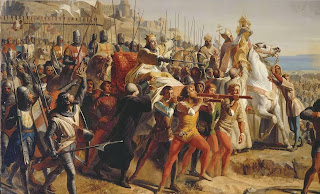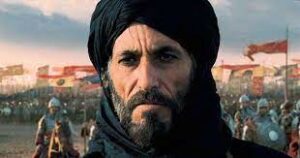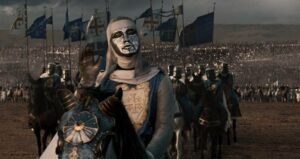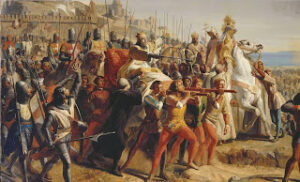November 27, 2023
The Battle of Montgisard: A Heroic Stand Against the Odds

Christianity and Islam, two titans of the religious world, came into conflict during the Crusades. On November 25, 1177, they met again, one led by a newly crowned king stricken with leprosy and with his back against the wall. The other was led by a man renowned as a great military leader who had captured many great cities of the world, like those in Eygpt. He also had survived many assassination attempts and won many battles to earn the claim to his position among his people. The clash of these two men would shake the religious world as they collided for divine dominance over the Holy Land.
In 1177, a sixteen-year-old King Baldwin the Ⅳ of Jerusalem, and Philip of Alsace (Flanders) planned an alliance with the Byzantine Empire. They were hoping to attack the nation of Egypt in a naval battle. Ruling Eygpt was Sultan Saladin, Sultan of both Eygpt and Syria, as the Caliph of Eygpt had died under mysterious circumstances six years prior. Baldwin, who was named King only a year earlier, was dead-set on defending the kingdom of Jerusalem from the fast-rising power of the nation of Islam. Saladin, however, had faced many hardships in the past year as a severe drought had been in effect for over a year, and the spring harvest had been less beneficial to him or to his army; he was also unable to move his Egyptian troops into Damascus due to the famine, nor was he able to tax his Syrian conquest to pay money back to Eygpt.1 Due to this unrest in the area, Baldwin and Phillp saw their opportunity to defend their land and weaken the Muslim forces that had been on their backs for so long.

Preparing for the battle, however, came with many hardships due to Baldwin’s illness. Starting to become more aggressive, he could not lead his army to Eygpt. So, a regent needed to be put into place in his stead. Reynald of Chatillon was that regent. He had previously been held captive for fifteen years by Muslum forces and was capable of great cruelty but had hardened due to his captivity. However, due to disputes between Phillip of Alsace and those loyal to King Baldwin and individuals in the Byzantine Empire, the plan to attack Egypt ended up falling apart because they could not decide who should rule the land if it was conquered. Those loyal to Baldwin wanted it to become part of the Kingdom of Jerusalem, while Phillip wanted it for his own, and the Byzantines wanted it to become part of their empire.2
Saladin, however, knew about the planned attack on Eygpt, and being a great military leader, he bolstered Eygpt’s defenses against the attack.3 However, when the withdrawal of the attack reached his ears, he wasted no time in rallying his forces for an attack on Jerusalem. Phillips of Flanders decided to take a group of troops to lay waste to northern Syria, which ultimately proved unprofitable.4 This is when Saladin decided to strike.

Baldwin had little war experience, due to his age and illness, and would generally have relied on his constable to handle all military issues to plan attacks or bolster the city’s defenses. However, Baldwin’s current constable was ill then, so it was up to the King’s regent, Reynald, to muster the forces needed to defend the kingdom.5 However, there were only 600 knights left in the city of Jerusalem itself, as many of them were taken with Phillip of Flanders to raid northern Syria; this was a fact that even Saladin was aware of.
Saladin led his forces toward the city of Ascalon, and this was when Baldwin and Reynald decided to march to meet Saladin, as they would not allow him to enter Christian territory so quickly. Reynald managed to mount a force of 3,000 cavalry soldiers and the 600 knights that the City of Jerusalem had, as they left the city without defenses as they knew Saladin would attempt to take them head-on should they beat him to Ascalon. Still, this force was only a fraction of what Saladin had, as he had already been prepared for war when Phillip of Flanders and Baldwin were attempting to invade Eygpt. Baldwin and his forces arrived and occupied Ascalon on November 22, 1177; Saladin and his forces came later that day and seemed surprised to see that Baldwin and his powers had beaten them to Ascalon.6 At first, Baldwin and his advisors did not know the total size of Saladin’s army, but as the ground shook and the sound of hooves was heard, Baldwin’s advisors knew they were severely outnumbered. They advised him to take their troops inside the fortress as they were camped outside its walls. Saladin sent a small raiding party to attack the defense, and Baldwin’s Frankish troops fended them off until the evening.
Saladin was determined to fight the Franks at all costs, as he could not let a threat to his area go unpunished. Saladin also wanted to claim the Kingdom of Jerusalem for himself, something he had wanted to do for a while now. The Crusaders had won Jerusalem in the First Crusade.7 After detaching a small force from his 26,000-soldier army to battle Baldwin’s forces at Ascalon, the Sultan decided to lead his army north. After a while, when Saladin believed he had gained enough distance from Ascalon, Saladin broke apart his army further into more raiding parties. The Sultan ordered these small parties to cut off supply lines to Jerusalem. However, Saladin had misjudged what Baldwin was thinking at the time, as he believed the sheer size of his army would have terrified Baldwin and his advisors; while this may have been true for Baldwin’s advisors, it was not the case for Baldwin himself.8
Saladin’s raiding parties swiftly took down city after city, such as the unfortified city of Lydda, as they marched their way through Palestine. Saladin had no choice but to keep moving as he had left his baggage train behind to travel faster through Palestine. Because of this, Saladin’s army lived off what they had taken from cities and what they foraged from the surrounding areas. Baldwin was outraged when he learned what Saladin and his army had been up to. He decided to take Saladin and his forces head-on despite the disparity in their armies’ sizes. He felt that as King, he could not stand idly aside while the people of his kingdom suffered at the hands of the Sultan.9
Baldwin, with the help of Reynald of Chatillon, devised a plan to break out of Ascalon; Baldwin would need to come up with a good strategy if he was going to win this battle, as courage itself was not enough to win against an army of 26,000 strong. Baldwin and his forces managed to break out of Ascalon with less trouble than they had initially expected. Then, they marched north towards Ibelin Castle. Baldwin made a camp outside the castle and waited to launch a surprise attack against the Sultan and his forces.10

On November 25, 1177, Baldwin’s scouts saw a large force of Saladin’s forces approaching from the south; the King commanded his troops to prepare for battle immediately. Fortunately for the Franks, Baldwin’s idea had come to fruition, and they had the opportunity to strike the particular force. Sultan Saladin himself led it, and fortunately for the Franks, they also caught the Sultan entirely off guard. When the Sultan saw the King approaching, he sent his scouts to gather as many of his forces from his smaller raiding parties as they could for this battle; then drums and horns echoed from the ranks of Saladin’s army, signaling that they were preparing for the fight to come.11 Before the battle started, Saladin had managed to muster 6,000 soldiers from his nearby raiding parties, which meant that he still outnumbered the Franks three to one in the approaching conflict.
When Baldwin saw Saladin’s number of soldiers, he second-guessed whether to take Saladin’s forces head-on. Still, after hearing the words of courage from Reynald of Chatillon, Baldwin resolved to lead his army into battle despite his illness, which had worsened to the point where he could barely ride his horse. Baldwin was also aware that all the wars that the Crusaders had fought in the past against the Muslims ended in a Muslim victory, but it was too late now to turn back. It was then that Baldwin ordered his bishop to lift the True Cross, which is believed to be the same cross that Jesus of Nazareth was crucified on; Baldwin prostrated himself in front of the cross and asked the Lord for the strength to win this battle and to give his men the courage that they needed; the sunlight beamed on the cross as if the light of god was shining upon Baldwin and his group of underdog soldiers.12
Both armies marched towards each other and met on the Hill of Montgisard. Baldwin rallied his troops and charged the Muslims, who were caught off guard by the smaller force charging straight toward them. In the forefront of the Frankish troops was King Baldwin himself, barely holding on to his horse as it galloped full speed towards the Muslims. The Sultan tried to rally his forces and muster a charge, then the chaos of battle ensued. Horses clashed with each other, and swords clashing could be heard across the battlefield.13 The Frankish forces kept to the offensive, which caused the mighty Muslum power to panic, leading to a break in formation and ranks. This was the opportunity that Baldwin’s forces needed to win, and they took it. Baldwin’s forces plowed through the center of Saladin’s forces and continued deeper into enemy lines.

Out of fear and the ongoing panic, Saladin forces began to retreat. Baldwin and his forces pressed on and continued to keep the pressure on them and chased them twelve miles outside Montgisard. This defeat that the Muslum forces faced was a shock not only to Saladin but to the Nation of Islam as a whole. Saladin parties even lied about the battle’s outcome, saying that the great Sultan won the war.14 This battle showed the Christian forces would not give up so quickly. Baldwin would reign as king for ten more years and was known as Jerusalem’s just and wise ruler. Saladin captured Jerusalem in 1187 after the death of Baldwin due to his leprosy, which left the Kingdom of Jerusalem without a leader to protect it. Saladin did not sack the city or kill its citizens, perhaps out of hidden respect for his once foe, King Baldwin the IV.
- Bernard Hamilton, The Leper King, and His Heirs: Baldwin IV and the Crusader Kingdom of Jerusalem (Cambridge: Cambridge University Press, 2000), 111, https://doi.org/10.1017/CBO9781107050662. ↵
- Jonathan Phillips, “The Rise of Saladin and the Battle of Hattin,” in The Crusades, 1095-1204 (London: Routledge, 2014), 150-151. ↵
- Bernard Hamilton, The Leper King, and His Heirs: Baldwin IV and the Crusader Kingdom of Jerusalem (Cambridge: Cambridge University Press, 2000), 113, https://doi.org/10.1017/CBO9781107050662. ↵
- Jonathan Phillips, “The Rise of Saladin and the Battle of Hattin,” in The Crusades, 1095-1204 (London: Routledge, 2014), 150-151. ↵
- Bernard Hamilton, The Leper King, and His Heirs: Baldwin IV and the Crusader Kingdom of Jerusalem (Cambridge: Cambridge University Press, 2000), 133, https://doi.org/10.1017/CBO9781107050662. ↵
- William E. Welsh, “A Day of Terrible Slaughter,” Medieval Warfare 6, no. 1 (2016): 30. ↵
- Jonathan Phillips, The Life and Legend of the Sultan Saladin (New Haven: Yale University Press, 2019), 116. ↵
- William E. Welsh, “A Day of Terrible Slaughter,” Medieval Warfare 6, no. 1 (2016): 30. ↵
- William E. Welsh, “A Day of Terrible Slaughter,” Medieval Warfare 6, no. 1 (2016): 31. ↵
- William E. Welsh, “A Day of Terrible Slaughter,” Medieval Warfare 6, no. 1 (2016): 31. ↵
- William E. Welsh, “A Day of Terrible Slaughter,” Medieval Warfare 6, no. 1 (2016): 31. ↵
- William E. Welsh, “A Day of Terrible Slaughter,” Medieval Warfare 6, no. 1 (2016): 34. ↵
- Bernard Hamilton, The Leper King, and His Heirs: Baldwin IV and the Crusader Kingdom of Jerusalem (Cambridge: Cambridge University Press, 2000), 135, https://doi.org/10.1017/CBO9781107050662. ↵
- Jonathan Phillips, The Life and Legend of the Sultan Saladin (New Haven: Yale University Press, 2019), 116. ↵
Tags from the story
Crusades
King Baldwin the Ⅳ of Jerusalem
Sultan Saladin
Tre Alcocer
I am a double History and Philosophy major at St.Mary’s University, Class of 2026. I hope on becoming a journalist in the future and traveling all over the world and meeting a whole lot of interesting people.
Author Portfolio Page